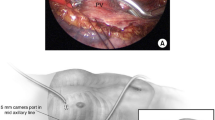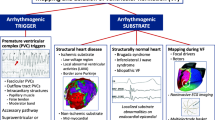Summary
The term “supraventricular tachyarrhythmia” summarizes electrophysiologically different arrhythmias. After detection of the mechanism of the present arrhythmia, the weak part of the reentrant circuit has to be identified using different mapping techniques. The catheter ablation is widely used as focal ablation (sinus tachycardia, ectopic atrial tachycardia, focal atrial fibrillation) or for interruption of conducting pathways (accessory pathways, AV nodal reentrant tachycardia). A single ablation line should be created in isthmus-dependent atrial flutter or in incisional tachycardias, which is less used now-a-days. Multiple ablation lines are needed for ablation of atrial fibrillation, which is a method investigated in arrhythmia centers only. Some arrhythmias are less well understood, not localizable and therefore not curatively treated with ablation techniques. Newer three-dimensional mapping methods may help in this situation. The challenge at the present time is the catheter ablation of atrial fibrillation.
Zusammenfassung
Hinter dem Begriff “supraventrikuläre Tachyarrhythmien” verbergen sich elektrophysiologisch unterschiedliche Rhythmusstörungen. Nach Identifizierung des Arrhythmiemechanismus' ist eine Lokalisation des Schwachpunktes der Rhythmusstörung durch verschiedene Mappingtechniken erforderlich. Danach erfolgt in der Regel die Ablation als fokale Ablation bei automatischen Arrhythmien (Sinustachykardie, ektope atriale Tachykardie, fokales Vorhofflimmern) oder zur Unterbrechung von Leitbahnen (Präexzitationssyndrom, AV-Knoten-Tachykardie). Eine singuläre Ablationslinie ist für das isthmusabhängige Vorhofflattern und für einige inzisionale Tachykardien erforderlich; dieses Vorgehen ist bereits weniger verbreitet. Multiple Ablationslinien sind für die Ablation eines Vorhofflimmerns erforderlich, was gegenwärtig nur in wenigen Zentren erfolgen kann. Verschiedene Arrhythmien sind bislang zu wenig verstanden, nicht induzierbar, nicht genau lokalisierbar und damit bislang nicht abladierbar. Neue, dreidimensionale Mappingmethoden könnten hier weiterhelfen. Die gegenwärtig größte Herausforderung der interventionellen Elektrophysiologie ist die Ablation des Vorhofflimmerns.
Similar content being viewed by others
Author information
Authors and Affiliations
Rights and permissions
About this article
Cite this article
Pfeiffer, D., Rother, T., Klein, N. et al. Katheterablation von supraventrikulären Tachyarrhythmien. Z Kardiol 89 (Suppl 10), X43–X50 (2000). https://doi.org/10.1007/s003920070007
Issue Date:
DOI: https://doi.org/10.1007/s003920070007




